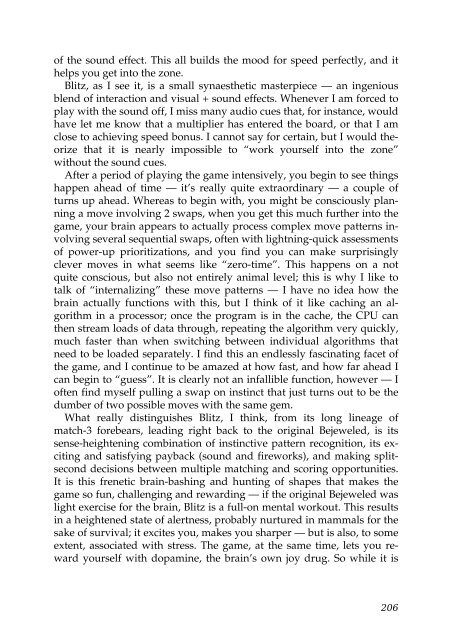Well Played 2.0: Video Games, Value and Meaning - OpenLibra
Well Played 2.0: Video Games, Value and Meaning - OpenLibra
Well Played 2.0: Video Games, Value and Meaning - OpenLibra
You also want an ePaper? Increase the reach of your titles
YUMPU automatically turns print PDFs into web optimized ePapers that Google loves.
of the sound effect. This all builds the mood for speed perfectly, <strong>and</strong> it<br />
helps you get into the zone.<br />
Blitz, as I see it, is a small synaesthetic masterpiece — an ingenious<br />
blend of interaction <strong>and</strong> visual + sound effects. Whenever I am forced to<br />
play with the sound off, I miss many audio cues that, for instance, would<br />
have let me know that a multiplier has entered the board, or that I am<br />
close to achieving speed bonus. I cannot say for certain, but I would theorize<br />
that it is nearly impossible to “work yourself into the zone”<br />
without the sound cues.<br />
After a period of playing the game intensively, you begin to see things<br />
happen ahead of time — it’s really quite extraordinary — a couple of<br />
turns up ahead. Whereas to begin with, you might be consciously planning<br />
a move involving 2 swaps, when you get this much further into the<br />
game, your brain appears to actually process complex move patterns involving<br />
several sequential swaps, often with lightning-quick assessments<br />
of power-up prioritizations, <strong>and</strong> you find you can make surprisingly<br />
clever moves in what seems like “zero-time”. This happens on a not<br />
quite conscious, but also not entirely animal level; this is why I like to<br />
talk of “internalizing” these move patterns — I have no idea how the<br />
brain actually functions with this, but I think of it like caching an algorithm<br />
in a processor; once the program is in the cache, the CPU can<br />
then stream loads of data through, repeating the algorithm very quickly,<br />
much faster than when switching between individual algorithms that<br />
need to be loaded separately. I find this an endlessly fascinating facet of<br />
the game, <strong>and</strong> I continue to be amazed at how fast, <strong>and</strong> how far ahead I<br />
can begin to “guess”. It is clearly not an infallible function, however — I<br />
often find myself pulling a swap on instinct that just turns out to be the<br />
dumber of two possible moves with the same gem.<br />
What really distinguishes Blitz, I think, from its long lineage of<br />
match-3 forebears, leading right back to the original Bejeweled, is its<br />
sense-heightening combination of instinctive pattern recognition, its exciting<br />
<strong>and</strong> satisfying payback (sound <strong>and</strong> fireworks), <strong>and</strong> making splitsecond<br />
decisions between multiple matching <strong>and</strong> scoring opportunities.<br />
It is this frenetic brain-bashing <strong>and</strong> hunting of shapes that makes the<br />
game so fun, challenging <strong>and</strong> rewarding — if the original Bejeweled was<br />
light exercise for the brain, Blitz is a full-on mental workout. This results<br />
in a heightened state of alertness, probably nurtured in mammals for the<br />
sake of survival; it excites you, makes you sharper — but is also, to some<br />
extent, associated with stress. The game, at the same time, lets you reward<br />
yourself with dopamine, the brain’s own joy drug. So while it is<br />
206

















